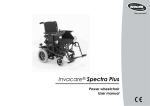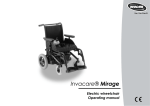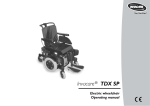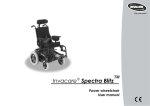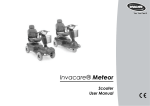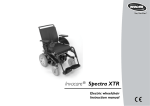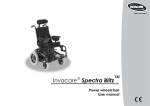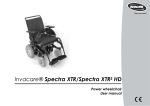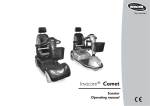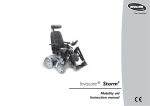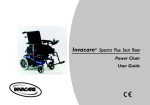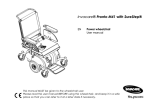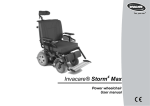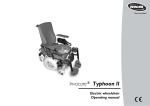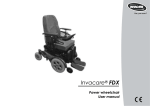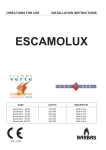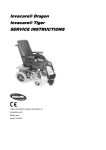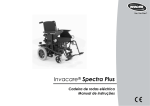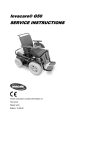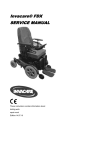Download Invacare® Spectra Plus
Transcript
Yes, You Can.® Invacare® Spectra Plus Electric wheelchair Instruction manual How can you get in touch with Invacare®? If you have any questions or need support, please contact your authorised Invacare® Dealer, who has the necessary know-how and equipment plus the special knowledge concerning your Invacare® product, and can offer you all-round satisfactory service. Should you wish to contact Invacare® directly, you can reach us in Europe at the following addresses and phone numbers. 2 Mobitec Mobilitätshilfen GmbH Herzog Odilostrasse 101 A-5310 Mondsee Austria : Fax: @: @: WWW: +43 6232 55 35 0 +43 6232 55 35 4 [email protected] [email protected] www.mobitec-austria.com Invacare® n.v. Autobaan 22 B-8210 Loppem (Brugge) Belgium : Fax: @: WWW: +32 (0)50 83 10 10 +32 (0)50 83 10 11 [email protected] www.invacare.be Mobitec Rehab AG Benkenstraße 260 CH-4108 Witterswil Switzerland : Fax: @: @: WWW: +41 (0)61 48 77 08 0 +41 (0)61 48 77 08 1 [email protected] [email protected] www.mobitec-rehab.ch Invacare Aquatec Alemannenstraße 10 88316 Isny Deutschland Fax @: WWW: +49 (0)75 62 7 00 0 +49 (0)75 62 7 00 66 [email protected] www.invacare-aquatec.de Invacare® A/S Sdr. Ringvej 37 DK-2605 Brøndby Danmark (Kundeservice): Fax (Kundeservice): @: WWW: +45 (0)36 90 00 00 +45 (0)36 90 00 01 [email protected] www.invacare.dk Invacare® SA c/ Areny, s/n Polígon Industrial de Celrà E-17460 Celrà (Girona) ESPAÑA : Fax: @: WWW: +34 (0)972 49 32 00 +34 (0)972 49 32 20 [email protected] www.invacare.es Invacare® Poirier SAS Route de St Roch F-37230 Fondettes France : Fax: @: WWW: +33 (0)247 62 64 66 +33 (0)247 42 12 24 [email protected] www.invacare.fr Invacare® Ltd Pencoed Technology Park Pencoed Bridgend CF35 5HZ United Kingdom (Customer Service): Fax (Customer Service): @: @: WWW: +44 (0)1656 776 222 +44 (0)1656 776 220 [email protected] [email protected] www.invacare.co.uk Invacare Mecc San s.r.l. Via Dei Pini, 62 I - 36016 Thiene (VI) ITALIA : Fax: @: WWW: +39 0445 38 00 59 +39 0445 38 00 34 [email protected] www.invacare.it Invacare Ireland Ltd. Unit 5 Seatown Business Campus Seatown Rd, Swords County Dublin Ireland : Fax: @: WWW: +353 18 10 70 84 +353 18 10 70 85 [email protected] www.invacare.ie Invacare® AS Grensesvingen 9 Postboks 6230 Etterstad N-0603 Oslo Norge (Kundeservice): Fax (Kundeservice): @: WWW: Invacare® B.V. Celsiusstraat 46 NL-6716 BZ Ede Nederland : Fax: @: WWW: +47 (0)22 57 95 00 +47 (0)22 57 95 01 [email protected] www.invacare.no +31 (0)318 69 57 57 +31 (0)318 69 57 58 [email protected] www.invacare.nl 3 Invacare Portugal, Lda Rua Estrada Velha, 949 P-4465-784 Leça do Balio Portugal 4 : : Fax: @: WWW: +351 225 1059 46 +351 225 1059 47 +351 225 1057 39 [email protected] www.invacare.pt Återförsäljare: Invacare® AB Fagerstagatan 9 S-163 91 Spånga Sverige (Kundtjänst): Fax (Kundtjänst): @: @: WWW: +46 (0)8 761 70 90 +46 (0)8 761 81 08 [email protected] [email protected] www.invacare.se Tillverkare: Invacare® Deutschland GmbH Kleiststraße 49 D-32457 Porta Westfalica Deutschland MÖLNDAL : Fax: @: +46 (0)31 86 36 00 +46 (0)31 86 36 06 [email protected] LANDSKRONA : Fax: @: +46 (0)418 285 40 +46 (0)418 180 89 [email protected] OSKARSHAMN : Fax: @: +46 (0)491 101 40 +46 (0)491 101 80 [email protected] Table of Contents Chapter 1 Page Introduction .....................................................................................9 1.1 1.2 1.3 1.4 1.5 1.6 2 Safety notes ...................................................................................16 2.1 2.2 2.3 2.4 3 4 5 Important symbols in this manual .......................................................................................11 Important symbols found on the vehicle .............................................................................12 Type classification and permissible use .............................................................................14 Guarantee ...........................................................................................................................14 Indications...........................................................................................................................15 Life expectancy...................................................................................................................15 General safety notes...........................................................................................................16 Safety information with regard to care and maintenance ...................................................19 Safety information on electromagnetic interference ...........................................................20 Safety information on driving and freewheel mode ............................................................21 Features .........................................................................................23 Getting in and out of the wheelchair ...........................................25 Driving ............................................................................................27 5.1 Before driving for the first time............................................................................................27 5.2 Taking Obstacles ................................................................................................................28 5.2.1 Maximum obstacle height ................................................................................................28 5.2.2 Safety information when ascending obstacles ................................................................28 5.2.3 The correct way to overcome obstacles ..........................................................................28 5.3 Driving up and down gradients ...........................................................................................29 6 7 Pushing the mobility device in freewheel mode.........................30 Remotes .........................................................................................31 5 8 Adjusting the wheelchair to the user's seating posture ............32 8.1 8.2 8.3 8.3.1 8.3.2 8.4 8.5 8.6 8.6.1 8.6.2 8.7 8.7.1 8.7.2 8.7.3 8.8 8.8.1 8.8.2 8.8.3 9 Seat Depth Adjustment - 35 mm depth adjustment............................................................33 Adjusting the backrest ........................................................................................................33 Armrest Adjustment ............................................................................................................35 Setting the height of the armrests....................................................................................35 Adjusting the width of the armrests .................................................................................36 Tension-Adjustable Backrest ..............................................................................................37 Adjusting the headrest ........................................................................................................38 Postural belts ......................................................................................................................39 Types of postural belts.....................................................................................................39 Adjusting the postural belt correctly.................................................................................40 Adjusting the trunk supports ...............................................................................................41 Adjusting the width...........................................................................................................44 Adjusting the height .........................................................................................................45 Adjusting the depth ..........................................................................................................46 Adjusting and removing the tray .........................................................................................47 Laterally adjusting the tray...............................................................................................47 Adjusting the depth of the tray / removing the tray..........................................................48 Swinging the tray away to the side ..................................................................................48 Adjusting footrests and legrests .................................................50 9.1 Removal - Standard............................................................................................................50 9.2 Removal - Swing - Away.....................................................................................................50 9.3 Adjustment ..........................................................................................................................51 9.3.1 Elevating Legrests ...........................................................................................................52 10 11 12 Manual Tilt-In-Space......................................................................53 Safety Cutout .................................................................................54 Operating the Chair Outdoors - Kerb Climbing ..........................55 12.1 12.2 6 Removal............................................................................................................................55 Re-Assembly ....................................................................................................................56 12.3 12.4 13 14 15 Dis-Assembly.................................................................................58 Detachable Motors ........................................................................61 Drive Wheel Removal ....................................................................63 15.1 16 Going up a Kerb................................................................................................................56 Going Down a Kerb ..........................................................................................................56 Drive Wheel Locks - Manual Brakes ................................................................................64 Transport........................................................................................65 16.1 Transferring the wheelchair to a vehicle...........................................................................66 16.2 Use of the wheelchair as a seat in a vehicle ....................................................................67 16.2.1 How the wheelchair is anchored in a vehicle for use as a vehicle seat ........................69 16.2.2 How the user is secured within the wheelchair..............................................................70 16.3 Transporting the wheelchair without occupants ...............................................................73 17 Electrical system ...........................................................................74 17.1 Electronics protection system ...........................................................................................74 17.2 Batteries............................................................................................................................75 17.2.1 What you need to know about batteries ........................................................................75 17.2.2 Charging the batteries ...................................................................................................77 17.2.3 How to handle damaged batteries correctly ..................................................................78 18 Maintenance...................................................................................79 18.1 Cleaning the mobility device .............................................................................................79 18.2 Inspection checks .............................................................................................................80 18.2.1 Before each use of the mobility device..........................................................................81 18.2.2 Weekly ...........................................................................................................................82 18.2.3 Monthly ..........................................................................................................................83 19 20 21 Refurbishment ...............................................................................84 Disposal .........................................................................................85 Fault Finding ..................................................................................86 7 22 8 Technical specifications ...............................................................87 1 Introduction Dear user, First we would like to thank you for purchasing our product! We hope that you will have a great deal of pleasure with your new power wheelchair. This operating manual contains important information and notes about: • Safety • Operation • Care and maintenance Please take care to read the operating manual thoroughly before starting out on your first journey. This wheelchair has been constructed for a large circle of users with different requirements. The decision whether the model is suitable for the user may only be taken by medical specialists with appropriate expertise. Invacare® or their statutory representatives can accept no liability in cases in which the wheelchair has not been adapted to suit the users’ handicaps. Some maintenance and settings can be performed by the user or his/hers attendants. Certain adjustments do however require technical training and may only be carried out by your Invacare® specialist dealer. Damages and errors caused by nonobservance of the operating manual or as a result of incorrect maintenance are excluded from all guarantees. 9 This manual contains copyrighted information. This manual may not be reproduced or reprinted either partly or completely without previous written consent from Invacare® or its statutory representatives. We reserve the right to make any necessary alterations on the grounds of technical improvements. 10 1.1 Important symbols in this manual WARNING! This symbol warns you of danger! • Always follow these instructions to avoid injury to the user or damage to the product! EXPLOSION HAZARD! This symbol warns you of an explosion hazard, which, for example, can be caused by excessive tyre pressure in a pneumatic tyre! • Always follow the instructions to avoid injury to the user or damage to the product! BURN HAZARD! This symbol warns you of burns due, for example, to leaking battery acid! • Always follow the instructions to avoid injury to the user or damage to the product! NOTE: This symbol identifies general information which is intended to simplify working with your product and which refers to special functions. Requirements: • This symbol identifies a list of various tools, components and items which you will need in order to carry out certain work. READ WELL BEFORE OPERATION! This symbol advises you to read information carefully. 11 1.2 Important symbols found on the vehicle This product has been supplied from an environmentally aware manufacturer. This product may contain substances that could be harmful to the environment if disposed of in places (landfills) that are not appropriate according to legislation. • The 'crossed out wheelie bin' symbol is placed on this product to encourage you to recycle wherever possible. • Please be environmentally responsible and recycle this product through your recycling facility at its end of life. This symbol indicates the position of an anchoring point for use with a tie-down system. If the symbol appears on a bright yellow sticker, the anchoring point is suitable for fixation of the wheelchair in a vehicle for use as a vehicle seat. If the symbol appears on a transparent sticker, the anchoring point can only be used to tie down the wheelchair for transport without the occupant seated in it. This wheelchair may be used as a vehicle seat, but only if it is equipped with the headrest that has been approved by Invacare for this purpose! • Please always make sure that the wheelchair is equipped with the headrest available from Invacare before using it as a vehicle seat! 12 This symbol indicates the maximum width to which an armrest may be adjusted. Pulling the armrest out further can cause it to fall out of it's fixation. For further information, see chapter "Adjusting the width of the armrests" on page 36. If the power wheelchair is fitted with a table, it is imperative that it is removed and safely stowed when transporting the wheelchair in a vehicle! 13 1.3 Type classification and permissible use This vehicle was designed for persons whose ability to walk is impaired, but who are still physically and mentally able to operate an electric vehicle. It has been classified according to EN 12184 as a class B mobility product (for indoor and outdoor areas). It is therefore compact and agile enough for indoor areas, but also able to overcome many obstacles in outdoor areas. You can find exact information on speed, turning radius, range, safe climbing ability, maximum obstacle height and permissible operating conditions in chapter "Technical specifications" starting from page 87. Please also pay attention to all safety information in chapter "Safety notes" starting from page 16. The vehicle was successfully tested according to German and international standards as to its safety. It was also tested successfully according to EN60529 IPX4 as to its resistance to spray water, and is therefore well suited for typical middle European weather conditions. When equipped with an appropriate lighting system, the vehicle is suitable for use on public roads. 1.4 Guarantee The terms and conditions of the guarantee are part of the general terms and conditions particular to the individual countries in which this product is sold. 14 1.5 Indications The use of this mobility product is recommended for the following indications: The inability or a greatly restricted ability to walk within the scope of the basic requirement to be able to move within one’s own four walls. The need to leave the dwelling place in order to get some fresh air during a short walk or to reach those places generally to be found at close distance to the dwelling and where everyday business is carried out. Provision of power wheelchairs for interior and exterior areas is advisable if the use of handoperated wheelchairs is no longer possible on account of the disability, yet proper operation of an electromotive drive unit is still practicable. 1.6 Life expectancy We estimate a life expectancy of five years for this product, provided it is used in strict accordance with the intended use as set out in this document and all maintenance and service requirements are met. The estimated life expectancy can be exceeded if the product is carefully used and properly maintained, and provided technical and scientific advances do not result in technical limitations. The life expectancy can also be considerably reduced by extreme or incorrect usage. The fact that we estimate a life expectancy for this product does not constitute an additional warranty. 15 2 Safety notes READ WELL BEFORE OPERATION! 2.1 General safety notes Danger of injury if mobility device is used in any other way than the purpose described in this manual! • Only ever use the mobility device in accordance with the instructions in this User's Manual (see chapter "Type classification and permissible use" on page 14). • Pay strict attention to the safety information. Danger of injury if the mobility device is driven when ability to operate a vehicle is impaired by medication or alcohol! • Never drive the mobility device under the influence of medication or alcohol. If necessary, the mobility device must be operated by an attendant who is physically and mentally able. Danger of damage or injury if mobility device is accidentally set into motion! • Switch the mobility device off before you get in, get out or handle unwieldy objects. • When the drive is disengaged, the brake inside the drive is deactivated. For this reason, pushing the mobility device by an attendant is only recommended on flat surfaces, never on gradients. Never leave your mobility device on a gradient with its motors disengaged. Always re-engage the motors immediately after pushing the mobility device (see chapter "Pushing the mobility device in freewheel mode" on page 30). 16 Danger of injury if the mobility device is switched off while driving, for example by pressing the On/Off Button or disconnecting a cable, due to it coming to an abrupt, sharp stop! • If you have to brake in an emergency, simply release the joystick which will bring you to a halt. (refer to the joystick operating manual for more information). Danger of injury when transferring mobility device to a vehicle for transport with the occupant seated in it! • It is always better to transfer the mobility device to a vehicle without the occupant seated in it. • If the mobility device needs to be loaded up a ramp together with its driver, ensure that the ramp does not exceed the maximum safe slope (see chapter "Technical specifications" from page 87). • If the mobility device does need to be loaded using a ramp which exceeds the maximum safe slope (see chapter "Technical specifications" from page 87), then you must use a winch. An attendant can safely monitor and assist the loading process. • As an alternative you can use a platform lift. Ensure that the total weight of the mobility device including the user does not exceed the maximum permissible weight for the platform lift or winch if you are using. Danger of injury if maximum permissible load is exceeded! • Do not exceed the maximum permissible load (see chapter "Technical specifications" from page 87). • The mobility device is only designed for use by a single occupant whose maximum weight does not exceed the maximum permissible load of the device. Never use the mobility device to transport more than one person. 17 Danger of injury due to wrong lifting or dropping of heavy components! • When maintaining, servicing or lifting any part of your mobility device, take into account the weight of the individual components especially the batteries. Be sure at all times to adopt the correct lifting posture and ask for assistance if necessary. Danger of falling out of the mobility device. • Do not slide forward on the seat, do not lean forward between your knees, do not lean backwards out over the top of the backrest, for example to reach an object. • If a posture belt is installed, it should be correctly adjusted and used each time you use the mobility device. • When transferring to a different seat, position the mobility device as close as possible to the new seat. Danger of injury by moving parts! • Make sure that no injury is incurred by moving parts of the mobility device, like wheels or one of the Lifter Modules (if fitted), especially when children are around. Danger of fire or breaking down due to electric devices being connected! • Do not connect any electric devices to your mobility device that are not expressly certified by Invacare® for this purpose. Have all electrical installations done by your authorised Invacare® Dealer. 18 2.2 Safety information with regard to care and maintenance Danger of accident and loss of guarantee if maintenance is insufficient! • For reasons of safety and in order to avoid accidents which result from unnoticed wear, it is important that this electric mobility product undergoes an inspection once every year under normal operating conditions (see inspection plan contained in service instructions). • Under difficult operating conditions such as daily travel on steep slopes, or in the case of use in medical care cases with frequently changing wheelchair users, it would be expedient to carry out intermediate checks on the brakes, accessories and running gear. • If the mobility product is to be operated on public roads, the vehicle driver is responsible for ensuring that it is in an operationally reliable condition. Inadequate or neglected care and maintenance of the mobility product will result in a limitation of the manufacturer's liability. 19 2.3 Safety information on electromagnetic interference This electric vehicle was successfully tested in accordance with International standards as to its compliance with Electromagnetic Interference (EMI) Regulations. However, electromagnetic fields, such as those generated by radio and television transmitters, and cellular phones, can influence the functions of electric vehicles. Also, the electronics used in our vehicles can generate a low level of electromagnetic interference, which however will remain within the tolerance permitted by law. For these reasons we ask you to please observe the following precautions: WARNING: Danger of malfunction due to electromagnetic interference! • Do not switch on or operate portable transceivers or communication devices (such as radio transceivers or cellular phones) when the vehicle is switched on. • Avoid getting near strong radio and television transmitters. • In case the vehicle should be set in motion unintentionally or the brakes are released, switch it off immediately. • Adding electrical accessories and other components or modifying the vehicle in any way can make it susceptible to electromagnetic interference. Keep in mind that there is no sure way to determine the effect such modifications will have on the overall immunity of the electronic system. • Report all occurrences of unintentional movement of the vehicle, or release of the electric brakes to the manufacturer. 20 2.4 Safety information on driving and freewheel mode Danger of injury if the wheelchair tips over! • Inclines and declines can only be travelled up to the maximum safe slope (see chapter "Technical specifications" from page 87). • Always return the backrest of your seat or the seat tilt to an upright position before ascending slopes. We recommend that you position the seat backrest and the seat tilt (if fitted) slightly to the rear before descending slopes. • Only ever drive downhill at a maximum of 2/3 of the top speed. Avoid abrupt braking or accelerating on gradients. • If at all possible, avoid driving on slippery surfaces (such as snow, gravel, ice etc.) where there is a danger of you losing control over the vehicle, especially on a gradient. If driving on such a surface is inevitable, then always drive slowly and with the utmost caution. • Never attempt to overcome an obstacle when on an uphill or downhill gradient. • Never attempt to drive up or down a flight of steps with your wheelchair. • When overcoming obstacles, always observe the maximum obstacle height (see chapter "Technical specifications" from page 87 and information about overcoming obstacles in chapter "Taking Obstacles" from page 28). • Avoid shifting your centre of gravity as well as abrupt joystick movements and changes of direction when the wheelchair is in motion. • Never use the wheelchair to transport more than one person. • Do not exceed the overall maximum permissible load or the maximum load per axle (see chapter "Technical specifications" on page 87). • Note that the wheelchair will brake or accelerate if you change the Driving Mode whilst the wheelchair is in motion. 21 Danger of breaking down in adverse weather conditions, i.e. extreme cold, in an isolated area! • If you are a user with severely limited mobility, we advise that in the case of adverse weather conditions DO NOT attempt a journey without an accompanying attendant! Danger of injury if your foot slides off the footrest and gets caught underneath the wheelchair when it is in motion! • Make sure each time before you drive the wheelchair that your feet are squarely and securely in place on the footplates, and that both legrests are properly locked into place. Danger of injury if you collide with an obstacle when driving through narrow passages such as doorways and entrances! • Drive through narrow passages in the lowest driving mode and with due caution. If your power wheelchair has been fitted with angle-adjustable legrests, there is a danger of personal injury and damage to the wheelchair if you drive the wheelchair with the legrests raised! • To avoid unwanted displacement of the wheelchair centre of gravity to the front (especially when travelling downhill) and in order to avoid damage to the wheelchair, angle-adjustable legrests must always be lowered during normal travelling. 22 CAUTION: Tipping hazard if anti-tip wheels (1) are removed, damaged or changed to a position different to the factory settings! • Anti-tip wheels should only ever be removed for dismantling the wheelchair for transport in a vehicle or for storage. • The anti-tip wheels must always be fitted if the wheelchair is being used. Note the position of the anti-tip wheels when you remove them so you can refit them in the correct position. 3 Features Motor speed and direction are regulated by the joystick control unit. With practice, control of acceleration, braking and change of direction will ensure a smooth, jerk-free ride. The variable speed selector gives you total control in any environment. The power chair cannot be driven when the batteries are being charged. Controller circuits are designed to prevent operation during the charging process. CHARGING BATTERIES The battery gauge will indicate that your batteries are low. Charging is straightforward, (Refer to enclosed booklet). The batteries fitted as standard are completely sealed and therefore cannot be spilled like conventional ‘wet’ cells. Total performance and reliable operation is dependent on the care and understanding of batteries and battery charging. Please refer to the appropriate section and separate booklet supplied. Sealed Gel batteries are classed as non hazardous by all air transport and travel authorities. Mobility vehicles fitted with these batteries can be safely taken onto aeroplanes, ships, buses, ambulances or 23 trains without having to remove the batteries from the equipment. Pneumatic drive wheels and castors are fitted as standard. Puncture proof wheels will alleviate the need to maintain pressures and give a smooth but slightly harder ride. These are available as options The upholstery complies with the requirements for resistance to cigarette and match UPHOLSTERY ignition ISO7176:16. Refer to section on cleaning and care of upholstery materials. Prolonged exposure to ultra-violet light will reduce the life of the upholstery, protect against sunlight. The knob fitted to your joystick is supplied as standard and is suitable for most OPTIONAL applications. If you find this unsuitable for your operation there is a range of JOYSTICK CONTROL KNOBS alternatives available. Please contact your wheelchair distributor for advice. Do not replace the joystick knob with any unauthorised device - it may cause hazardous operation. TYRES 24 4 Getting in and out of the wheelchair Learning how to get in and out of a wheelchair safely and without injury is most important. Transferring to and from your powerchair may require practice and a good sense of balance. It is recommended that whenever possible you have assistance when transferring to and from your powerchair. It is recognised, however, that situations may occur when assistance is not available. It is desirable to learn and practice different techniques to accomplish a safe transfer. Many experienced wheelchair users have developed and mastered their own method of transferring to and from the chair, resulting in great independence and self-care. Such ability depends largely on the strength of the individual, their capabilities and the type of chair. No single technique would be practical, or possible, for all wheelchair users. Safety is the primary consideration in all techniques. To carry out the transfer confidently and to eliminate the possibility of personal injury, check the following: Getting into the wheelchair: • Position your wheelchair as close as possible to your seat. This might have to be done by an attendant. • Switch your wheelchair off. • Apply the manual wheel lock of your wheelchair (if existing). • Detach the skirt guard of your wheelchair or swivel it up. • Now slide into the wheelchair. 25 Getting out of the wheelchair: • Drive your wheelchair as close as possible to your seat. • Switch your wheelchair off. • Apply the manual wheel lock of your wheelchair (if existing). • Detach the skirt guard of your wheelchair or swivel it up. • Now slide onto your new seat. NOTE: If you do not have sufficient muscle strength, you should ask other persons for help. Use a sliding board, if possible. 26 5 Driving NOTE The maximum load capacity that is stated in the technical data only states that the system is designed for this mass in total. However, this does not mean that one can sit a person with this body weight in the wheelchair without restrictions. Attention must be paid to the body proportions, such as height, weight distribution, abdominal girth, leg and calf girth and seat depth. These factors have a strong influence on driving features such as tilt stability and traction. The permissible axle loads in particular must be adhered to (see chapter "Technical specifications" as from page 87)! It may possibly be necessary to carry out adaptations to the seat system. 5.1 Before driving for the first time... Before you take your first trip, you should familiarise yourself well with the operation of the vehicle and with all operating elements. Take your time to test all functions and driving modes. NOTE: If installed, make sure to properly adjust and use the postural belt each time you use the wheelchair. Sitting Comfortably = Driving Safely Before each trip, make sure that: You are within easy reach of all operating controls. • The battery charge is sufficient for the distance intended to be covered. • The postural belt (if installed) is in perfect order. 27 5.2 Taking Obstacles 5.2.1 Maximum obstacle height You can find information about maximum obstacle heights in the chapter entitled "Technical specifications" from page 87. 5.2.2 Safety information when ascending obstacles CAUTION: Danger of Tipping Over! • Never approach obstacles at an angle but at 90 degrees as shown below. • Put your backrest into an upright position before climbing an obstacle. 5.2.3 The correct way to overcome obstacles Ascending and descending The same approach applies to both ascending and descending obstacles: Right • Approach the obstacle or the kerb slowly and at a right angle. • Stop shortly before the front wheels come into contact with the obstacle. • Check the position of the front wheels. They must be in driving direction and at right angles to the obstacle. • Approach slowly and keep at a consistent speed until the rear wheels have also passed over the obstacle. 28 Wrong 5.3 Driving up and down gradients For information concerning the maximum safe slope, please see chapter "Technical specifications" starting on page 87. WARNING: Danger of tipping over! • Only ever drive downhill at a maximum of 2/3 of the top speed. Avoid sudden changes of direction or abrupt braking when driving on slopes. • Always return the backrest of your seat or the seat tilt (if adjustable seat tilt is available) to an upright position before ascending slopes. We recommend that you position the seat backrest or the seat tilt slightly to the rear before descending slopes. • Always lower the lifter (if fitted) to its lowest position before ascending or descending a slope. • Never attempt to ascend or descend a slope on slippery surfaces or where there is a danger of skidding (such as wet pavement, ice etc). • Avoid trying to get out of the vehicle on an incline or a gradient. • Always drive straight in the direction the road or path you are on goes, rather than attempting to zigzag. • Never attempt to turn around on an incline or a slope. Braking distance is much longer on a downhill slope than on even terrain! • Never drive down a slope that exceeds the maximum safe slope (see chapter "Technical specifications" on page 87). 29 6 Pushing the mobility device in freewheel mode The power wheelchair supplied is fitted with the lever dis-engage type motors. To dis-engage the drive to allow the chair to be pushed the following instructions should be followed carefully. • To dis-engage the drive, operate the levers to the position A shown in the illustration below. LEVERS POINTING OUTWARDS. • To re-engage the drive, operate the levers to position B shown in the illustration below. LEVERS POINTING REARWARDS. • Push the chair slightly forwards to ensure that both motors are fully locked in the drive position. CAUTION! When the drive is dis-engaged there are no brakes, unless the wheel-locks are applied. Before entering or leaving the chair always re-engage the drive on both sides. On no account disengage the drive when the chair is occupied, unless being pushed by an attendant. 30 WARNING! Freewheel device • Always re-engage the freewheel device after use (position B in the illustration above). Failure to do so may result in injury. 7 Remotes Your wheelchair may be equipped with one of several different remotes. For information on the different functions and how to operate a particular remote, please see it's corresponding User Manual. 31 8 Adjusting the wheelchair to the user's seating posture CAUTION: Damage to wheelchair and accident hazard! It is possible that collisions can occur between wheelchair components due to various combinations of adjustment options and their individual settings! • The wheelchair is fitted with an individual, multiply adjustable seating system including adjustable legrests, armrests, a headrest or other options. These adjustment options are described in the following chapters. They are used to adapt the seat to the physical requirements and the condition of the user. When adapting the seating system and the seat functions to the user, ensure that no wheelchair components collide. Note Initial setup should always be done by a healthcare professional. Adjustment by the user is only recommended after they have been given appropriate guidance by the healthcare professional. WARNING! It should be noted that under certain conditions, and configurations of the wheelchair, ie. for users with limited / no lateral body control, and with the backrest in the reclined position, there is the potential to create a body trap between the armrest / sidepanel and the backrest. Suitable accessories are available from Invacare (lateral trunk supports) to eliminate this risk. Before sitting in the chair, make sure it is NOT switched ON. If it is ON, the battery condition indicator (10-bar display) will be illuminated. 32 8.1 Seat Depth Adjustment - 35 mm depth adjustment The individual fitting of the seating allows the seat depth to be adjusted by 35 mm (1“). The adjustment, which is usually only done once, is carried out as follows. You will need a large crossheaded screwdriver and a 13 mm spanner. • Prise off plastic cap at point A, unscrew and remove the screw and nut, repeat each side. • Move the backrest mounting bracket backwards to the extended position. Replace the nut and screw into the selected hole and firmly fasten, replace plastic cap, repeat each side. 8.2 Adjusting the backrest The backrest angle can be adjusted from 90° rearwards through 12° The adjustment, which is normally only required to be done once, is carried out in the following sequence (see diagram) with the aid of the 13 mm spanner and the cross-headed screwdriver. Do the same adjustment for both sides. 33 • Release the lock nut B located on the cross-headed screw. • Screw the locking hand-wheel C partially out. • Screw the cross-headed screw in or out to give the desired position. Adjust position of hand-wheel as necessary. • Position the lock nut B up to the mounting bracket and fully tighten. • Re-tighten the hand-wheel C fully; ensure backrest assembly is secure. Please note: Each backrest tube must be positioned in the same plane or the backrest will be twisted. The backrest can be either folded down or detached from the chair base. Follow these additional instructions: • Unscrew the hand-wheel C approximately five full turns. Lift the backrest upwards and then fold forwards onto the seat. Adjust armrest width to accommodate if required. • To detach, unscrew the hand-wheel an additional three to four turns. Do not loosen the crossheaded screw. • Push the backrest slightly forward and lift upwards. 34 • To re-locate the backrest assembly, ensure the pins are correctly aligned into the slots of the mounting bracket, fully re-tighten the hand-wheel on both sides. 8.3 Armrest Adjustment 8.3.1 Setting the height of the armrests • The armrest can be pre-set for height by positioning the self-tapping screw (F) in one of the holes in the armrest tube. • To adjust the height of each armrest, first release the locking lever (E) which clamps the arm tube, while holding onto the armrest. • Move the armrest to the desired height position, re-tighten the locking wing screw (E). The locking lever (if fitted) can be repositioned without losing the clamping pressure, pull the lever slightly outwards and turn to a more suitable locating angle. • The padded side panel can also be set to a desired height. Loosen the slotted screw (D) located in the fixing bracket, re-tighten when desired position is achieved. 35 8.3.2 Adjusting the width of the armrests • The transverse width adjustment is achieved by releasing locking lever (G) and positioning the armrest tube to width required and re-tightening locking lever (G). • To remove the transverse width adjustment armrest assembly complete to allow removal of the front battery box/controller assembly: remove seat, release locking lever (G), depress spring button lock (F) and withdraw complete armrest unit sideways. NOTE: When re-assembling to chair always ensure the spring button lock (F) is on the inside of the horizontal mounting tube of the sideframe to prevent accidental dismantling of armrest unit. CAUTION: The armrests are not intended for carrying the wheelchair! 36 8.4 Tension-Adjustable Backrest The backrest upholstery tension can be adjusted to achieve the desired comfort for individual user requirements. • To achieve this, lift the backrest upholstery cover by peeling the Velcro fastening and fold clear. • Adjust the individual tension straps to the occupant’s comfort. • Ensure the straps are correctly positioned and replace the backrest cover, attaching securely by the Velcro fastening. 37 8.5 Adjusting the headrest CAUTION: Injury hazard during use of the mobility aid as a vehicle seat if a headrest is wrongly adjusted or not installed! This can cause the neck to be hyperextended during collisions! • A headrest must be installed! The headrest optionally supplied for this mobility device by Invacare® is perfectly suitable for use during transport. • The headrest must be adjusted to the user's ear height. • Loosen the clamping lever (1, 2 or 3). • Adjust the headrest to the required position. • Retighten clamping lever. 38 8.6 Postural belts A postural belt is an option which can either be fixed to the wheelchair ex-works or can be retrofitted by your specialist dealer. If your wheelchair is fitted with a postural belt, your specialist dealer will have informed you about fitting and usage. The postural belt is used to help the wheelchair user keep an optimum sitting position. Correct use of the belt assists the user in sitting securely, comfortably and well-positioned in the wheelchair, especially for such users who do not have such a good sense of balance while sitting. NOTE: We recommend using the postural belt whenever the wheelchair is used. The belt should be tight enough to ensure that you are sitting comfortably and that your body is in the correct sitting position. 8.6.1 Types of postural belts Your wheelchair can be fitted with the following postural belt types ex-works. If your wheelchair has been fitted with a different belt to those listed below, please ensure that you have received the manufacturer's documentation with regard to correct fitting and use. Belt with metal buckle, adjustable one side Belt can only be adjusted on one side which can result in the buckle not sitting centrally. 39 Belt with metal buckle, adjustable both sides Belt can be adjusted on both sides. This means that the buckle can be centrally positioned. 8.6.2 Adjusting the postural belt correctly • Ensure that you are sitting correctly, which means that you are sitting right at the back of the seat, your pelvis is positioned erect and as symmetrically as possible, not to the front, to the side or at one edge of the seat. • Position the postural belt so that your hipbones can be easily felt above the belt. • Adjust the belt length using one of the adjustment aids described above. The belt should be adjusted so that you can fit a flat hand between the belt and your body. • The buckle should be positioned as centrally as possible. In doing so, please carry out adjustments on both sides as much as possible. • Please check your belt every week to ensure that it is still in good working condition; to ensure it has no damage or wear, and that it is fixed properly to the wheelchair. If the belt is only fastened with a bolted connection, ensure that the connection has not loosened or undone. You can find more information about maintenance work on belts in the service manual, which is available from Invacare®. 40 8.7 Adjusting the trunk supports THE TRUNK SUPPORTS CAN ONLY BE FITTED TO THE FIRM UPHOLSTERED BACKREST ASSEMBLY (VISCOUNT SEATING). To attach the trunk supports to the back of the backrest assembly follow these instructions. • Remove the existing pan-head screws from the top of each flange shown in Fig 1. Marked (A). The lower screws of each flange remain in place. Fig. 1 41 • Line up the support rail with the holes in the backrest as shown in Fig. 2. Fig. 2 42 • With the longer screws provided attach the support rail to the backrest through the flanges into the screw inserts. Do not screw into the backboard. Tighten securely, but do not overtighten as this may damage the screw threaded inserts. • With the support rails secured, slide the trunk support into the support rail from the bottom. Adjust to the occupant’s requirements and firmly tighten the hand wheel (B). 43 8.7.1 Adjusting the width • Loosen the knobs (1) that hold the lateral supports. • Adjust the supports to the desired width. • Re-tighten the knobs. 44 8.7.2 Adjusting the height Requirements: • Allen key 5 mm • Loosen the screws (1) that allow height adjustment of the lateral supports. • Adjust the supports to the desired height. • Re-tighten the screws. 45 8.7.3 Adjusting the depth Requirements: • Allen key 5 mm • Loosen the screws (1) that allows the support pads to slide forwards and backwards. • Adjust the supports to the desired position. • Re-tighten the screws. 46 8.8 Adjusting and removing the tray CAUTION: Injury hazard or material damage if a power wheelchair which is fitted with a table is transported in a vehicle! • If a table is fitted, always remove it before transporting the wheelchair. 8.8.1 Laterally adjusting the tray • Loosen the wing-screw (1). • Adjust the tray towards the left or right. • Re-tighten wing-screw. 47 8.8.2 Adjusting the depth of the tray / removing the tray • Loosen the wing-screw (1). • Adjust the table to the desired depth (or remove it entirely). • Re-tighten the screw. 8.8.3 Swinging the tray away to the side The tray can be swivelled up and away to the side to allow the user to get in and out of the mobility device CAUTION! Risk of injury! When the tray is raised it does not lock in place in this position! • Do not tilt the tray up and leave it leaning in this position. • Never attempt to drive with the tray tilted up. • Always lower the tray in a controlled manner. 48 The tray can be swivelled upwards and pushed to the side as illustrated to enable getting on and off. 49 9 9.1 Adjusting footrests and legrests Removal - Standard Release winged screw A and slide the complete assembly from the seat frame. Ensure the winged screw is fully tightened when the footrest assembly is replaced. 9.2 Removal - Swing - Away Release the locking lever, swing footrest to the side, or lift up and off. Do this before sitting in the chair. CAUTION! • It is recommended that both footrests are firmly locked in place when seated in the chair (particularly when driving the chair). • NEVER stand on the footplates. If the weight of the body is placed on the footplates, damage may occur and the chair may tip forward. 50 9.3 Adjustment • To extend the footrest laterally, release the winged screw A, pull the footrest forward, retighten when the desired position is achieved. It is not necessary to release the grub screw B. This should remain permanently in position. • To adjust the footrest length, loosen the hex nut C on the extension tube, use a twisting motion when sliding the telescopic tube in and out. Be sure to re-tighten the nuts securely when the desired height is achieved. Caution! • The lowest part of the footrest must be at least 60 mm (2") from the ground for clearance! 51 9.3.1 Elevating Legrests • To raise or lower the legrest, release the lock by moving the lever forward as shown. • When lowering the legrest, support the weight of user’s leg then release the lock, keep it from dropping too quickly. Keep in mind that the lowest part of the footplate must be 60 mm (2”) from the ground. 52 10 Manual Tilt-In-Space To operate the manual tilt-in-space to allow the complete seat/backrest to tilt backwards, turn the large hand-wheel A until the desired sitting position is achieved. Rotating the hand-wheel in the opposite direction will lower the seat/backrest section. CAUTION! • WHEN DRIVING THE POWER CHAIR WITH THE TILT-IN-SPACE OUTDOORS, THE SEAT TILT MUST BE RETURNED TO THE NORMAL LOWERED POSITION BEFORE ATTEMPTING KERB CLIMBING OR ASCENDING AND DESCENDING SLOPES. THIS ALSO APPLIES TO THE OPTIONAL POWERED TILT-IN-SPACE OR POWERED RECLINING BACKREST. 53 11 Safety Cutout The circuit breakers are located at the front of the front battery box and at the front of the rear battery box between the two battery boxes. They are designed to operate should a stall condition occur. This happens when a chair is unable to negotiate an obstacle such as a narrow doorway or a kerb of excessive height. If one of the breakers operates, it will ‘pop’ out. To re-set after a circuit breaker operation, pause for a few minutes then push both battery buttons in. If the circuit breaker continually fails, consult your authorised INVACARE dealer. Under certain circumstances, particularly indoor use, care must be taken to ensure safe continual operation of the motor units. If an obstacle is encountered or, with slow manoeuvring of the castor wheels from the forward to rear position, continual full operation of the joystick control will result in motor overload and eventual failure. To prevent this occurrence, increase the speed to maximum, control the manoeuvre by the joystick control, always move away from the obstacle, do not continue to drive against it. 54 12 Operating the Chair Outdoors - Kerb Climbing NOTE: Always remember to use the safety belt when operating the chair outdoors. Ensure the footrests are locked in position. 12.1 Removal (Please note that left or right hand are identified as though being seated in the chair). To detach the kerb climber for transportation follow these simple instructions: • Remove the locking pin A, while holding the assembly. Push the assembly down to release from the locating bracket. • Pull the assembly towards you away from the right hand retaining socket. The kerb climber is now detached. Stow carefully. 55 12.2 Re-Assembly Locate the assembly into the right hand retaining bracket. Push the assembly up into the left hand bracket and refit the locking pin A. Ensure the pin is correctly fitted firmly into place. 12.3 Going up a Kerb • Adjust the speed control to the maximum position to allow full power to the Right motors. • Approach the kerb head-on (90º), do not charge at the kerb. • With the front of the kerb climber at about 25 mm (1“) from the edge of the kerb, push the joystick fully forward and continue to climb in one movement. Do not pause or attempt to steer during this movement. Wrong If the kerb climb is un-achievable do not continue the manoeuvre, move away from the obstacle and if possible find an alternative location. 12.4 Going Down a Kerb Approach the edge of the kerb square on. Drive forward down the kerb at a moderate speed. Kerbs of 75 mm (3“) or more may tip the chair onto the foot plates. It is advisable to go down the kerb backwards to overcome this problem. 56 The kerb climbing device will return to the climbing position after each manoeuvre. NOTE: Climbing kerbs in excess of 100 mm (4“) will be restricted if the foot plates are in the fully extended position. Refer to "Adjustment" on page 51 for correct footplate adjustment. 57 13 Dis-Assembly To enable the chair to be carried in the boot of most cars, follow these instructions: Step 1: Disconnect the Motor/Battery connector from the control box and remove the armrests. Release the locking lever. Step 2: Remove the calf strap from the footrests. This is simply attached by Velcro fastening. Remove the footrests completely by releasing the cam latch situated on the inside of the footrest frame hanger. CAUTION: • Do not drive the chair with the footrests in the unlatched position. Step 3: Remove the kerb climber assembly (if fitted) as described. Step 4: Detach the seat and backrest assembly as previously shown. When replacing the seat assembly, ensure the brackets are located correctly on the seat frame tube. 58 If the backrest has an electrical recliner, refasten the motor to the backpost. CAUTION: Injury hazard if the clevis pin of the motor of the electrical recliner is not correctly secured! An incorrectly secured pin can come off and the backrest can unexpectedly fold back, which can lead to injuries. • Make absolutely sure that you insert the R-clip to secure the clevis pin correctly. The clip must fit snugly around the pin! See the illustrations below: 59 Step 5: Disconnect the motor leads and the connecting cables from the battery boxes. Carefully lift the battery boxes clear of the frame by the straps provided. Remove the battery tray. When refitting the battery tray it is important that it is correctly located on the support pins. Step 6: Remove the detachable motors as described. The disassembled chair is now ready to be loaded safely in a suitable vehicle. Reversing the procedure will allow the chair to be reassembled at your destination. SPECIAL NOTE: Care must be taken when stowing the detached parts for transportation to ensure that no damage occurs, particularly to the motor assemblies and controller units. Due to the weight of the battery boxes, consideration must be given to their secure positioning in the event of emergency braking. EXTREME CARE MUST BE TAKEN WHEN LIFTING THE HEAVIEST COMPONENTS I.E. BATTERY BOXES, FRAME AND MOTOR UNITS. ASSUME THE CORRECT LIFTING POSITION. SEEK ASSISTANCE IF IN DOUBT. 60 14 Detachable Motors For practical purposes and ease of operation, it is advisable to detach the motors as the last component of the chair to be dismantled and to re-attach first. NOTE: Assistance may be required while this operation is carried out. Step 1: Unscrew the knurled locking knob A. This can be unscrewed completely and still be retained in position. Step 2: Release the side retaining pin B by turning it 180°. Step 3: Unbolt clamp C on the vertical frame member. Step 4: Support the weight of the chair on the side the motor is being detached. Pull the motor assembly towards the back of the chair, take care to hold the motor assembly when it becomes detached. Repeat operation for both sides. SPECIAL NOTE: Care must be taken when stowing the detached parts for transportation to ensure that no damage occurs, particularly to the brake housing and gearbox unit. 61 To re-attach the motor assemblies, align the bottom tube rail with the tube of the motor assembly and push firmly home. Re-tighten fully the knurled locking knob A. Do the same for both sides. For ease of operation, it is advisable to re-attach the motor assemblies as the first operation in the reassembly of the wheelchair after transportation. NOTE: The disassembly and reassembly of the motor assemblies can be handled and attached easier if the chair is carefully tipped onto the front, taking into account that the leg rests are not attached. The chair can be transported disassembled safely in a suitable vehicle. Reversing the above procedures will make your chair ready at your destination. 62 15 Drive Wheel Removal To remove the rear drive wheels for puncture repairs carefully follow these instructions. Release the four bolts shown as A in the diagram. Check the tyres for wear, if excessive, replacement is recommended. The wheel is a split rim. It is important that the bolts securing the rims together are NOT released if the tyre is pneumatic and INFLATED. Upon reassembly tighten the fixing bolts securely. The wheel is alloy, do not over-tighten as this may damage the wheel rim. If the tyre is being inflated with the wheel on the chair, ensure the wheel is off the ground during inflation. Inflate the tyre slowly to recommended pressure, ensuring an even fit around the rim. 63 15.1 Drive Wheel Locks - Manual Brakes When transferring to and from the chair ensure the wheel locks are firmly ON and the motor drive is in the engaged position. When transporting the complete chair in a vehicle, it is important that motor drive is engaged and the wheel locks are firmly ON. This will aid the use of the chair restraints and protect the motor/gearbox from possible damage. 64 16 Transport CAUTION: Injury hazard or material damage if a power wheelchair which is fitted with a table is transported in a vehicle! • If a table is fitted, always remove it before transporting the wheelchair. CAUTION: Danger of death or serious injury to the mobility device user and potentially any other nearby occupant of the vehicle, if a mobility device is secured using a 4-point tie-down system available from a third party supplier and the unladen weight of the mobility device exceeds the maximum weight for which the tie-down system is certified! • Make sure the weight of the mobility device does not exceed the weight for which the tiedown system is certified. Consult the tie-down manufacturer's documentation. • If you are unsure how much your mobility device weighs, then you must have it weighed using calibrated scales. 65 16.1 Transferring the wheelchair to a vehicle WARNING: Danger of tipping over, if the wheelchair is transferred to a vehicle using a ramp that exceeds the maximum safe slope, or if the backrest is not in an upright position during transfer! • If the wheelchair has to be transferred to a vehicle using a ramp that exceeds the maximum safe slope (see chapter "Technical specifications" starting on page 87), then a winch must be used. An attendant can then safely oversee and assist the transfer process. • If no winch is installed, then the wheelchair must not be transferred to a vehicle using a ramp that exceeds the maximum safe slope. • Alternatively, a tail lift installed in the vehicle may be used. • Only ever transfer the wheelchair to a vehicle with the backrest in an upright position. Ensure that the total weight of the mobility aid including the user does not exceed the highest permissible weight for the platform lift. • Only ever run the wheelchair with the seat back in the upright position, seat lifter lowered and the seat tilting in the upright position into the transport vehicle (please refer to chapter "Driving up and down gradients" on page 29). • Drive or push your wheelchair into the transport vehicle using a suitable ramp. 66 16.2 Use of the wheelchair as a seat in a vehicle Please note In order to use a wheelchair as a motor vehicle seat, it needs to be equipped with attachment points to enable anchoring in the motor vehicle. These accessories may be included in the standard scope of wheelchair order and delivery in some countries (UK for example), but may also be obtained from Invacare® as an option in other countries. This power wheelchair complies with the requirements of ISO 7176-19:2001 and may be used as a vehicle seat in connection with an anchoring system that has been checked and approved in accordance with ISO 10542. The wheelchair has undergone a crash test in which it was anchored in the transporting vehicle's direction of travel. Other configurations were not tested. The crash test dummy was secured using pelvic and upper body safety belts. Both types of safety belt should be used in order to minimise the risk of injuries to head or upper body. It is imperative that the wheelchair is inspected by an authorised dealer before being used again after being involved in a crash. Alterations to the wheelchair anchoring points may not be carried out without the manufacturer's permission. 67 Caution: There is a danger of injury if the wheelchair is not properly secured during use as a vehicle seat! • If possible, the user should always leave the wheelchair to use a vehicle seat and the safety belts provided with the vehicle. • The wheelchair should always be anchored facing in the transport vehicle's intended direction of travel. • The wheelchair must always be secured in accordance with the wheelchair and anchoring system manufacturers’ operating manual. • Always remove and secure any accessory parts fixed to the wheelchair such as chin controls or tables. • If your wheelchair is equipped with an angle adjustable backrest, then it must be placed in an upright position. • Fully lower elevated legrests, if fitted. • Fully lower the seat lifter, if fitted. WARNING: Danger of injury exists if a power wheelchair that is not equipped with leakproof batteries is transported in a vehicle! • Only ever use leak-proof batteries! WARNING: Danger of injury or damage to the wheelchair or to the transporting vehicle, if the legrests are in a raised position while the wheelchair is used as a vehicle seat! • Always completely lower height-adjustable legrests, if fitted. 68 16.2.1 How the wheelchair is anchored in a vehicle for use as a vehicle seat The power wheelchair is fitted with four anchoring points, which are labelled with the symbol shown on the right. Snap hooks or belt loops can be used for fixation. • Secure the wheelchair at the front (1) and at the rear (2) with the anchoring system belts. • Secure the wheelchair by tensioning the belts in accordance with the anchoring system manufacturer's instruction manual. Front (only left-hand side visible in picture) Rear (only left-hand side visible in picture) 69 16.2.2 How the user is secured within the wheelchair CAUTION: There is a danger of injury if the user is not properly secured within the wheelchair! • Even if the wheelchair is fitted with a postural belt, this is no substitute for a proper safety belt which complies with ISO 10542 in the transport vehicle. Always use the safety belt installed in the transport vehicle. • Safety belts must be in contact with the user's body. They must not be held at a distance from the user's body using parts of the wheelchair such as armrests or wheels. Refer to the illustration on page 72. • Safety belts must be pulled as tightly as possible without causing the user discomfort. Refer to the illustration on page 72. • Safety belts must not be positioned while twisted. • Ensure that the third seatbelt anchorage point is not fixed directly to the vehicle floor, but to one of the vehicle uprights. 70 CAUTION: Injury hazard during use of the mobility aid as a vehicle seat if a headrest is wrongly adjusted or not installed! This can cause the neck to be hyperextended during collisions! • A headrest must be installed! The headrest optionally supplied for this mobility device by Invacare® is perfectly suitable for use during transport. • The headrest must be adjusted to the user's ear height. 71 Seat belts may not be held at a distance from the user's body using parts of the wheelchair such as armrests or wheels. 72 The pelvic belt should be positioned in the area between the user's pelvis and thighs so that it is unobstructed and not too loose. The ideal angle of the pelvic belt to the horizontal is between 45° and 75°. The maximum permissible angle is between 30° and 75°. The angle should never be less than 30°! The safety belt installed in the transporting vehicle should be applied as shown in the illustration at right. 1) Centre line of the body 2) Centre of the sternum 16.3 Transporting the wheelchair without occupants CAUTION: Injury hazard! • If you are unable to fasten your electric wheelchair securely in a transport vehicle, we recommend that you do not transport it! • Before transporting your wheelchair, make sure the motors are engaged and that the Joystick Box is switched off. • We urgently recommend securing the wheelchair to the floor of the transporting vehicle. 73 17 17.1 Electrical system Electronics protection system The vehicle drive electronics is fitted with an overload protection. If the drive is severely overloaded over a long period (e.g. during steep climbs) and, above all, at simultaneous high external temperatures, the electronic system can overheat. In this case, the vehicle performance is gradually reduced until it comes to a standstill. The status display shows a corresponding blink code (please refer to the instruction manual for your remote). If you switch the drive electronics off and then on again, the error message is deleted and the electronics can be switched on again. It can however take up to five minutes until the electronics has cooled down enough for the drives to apply their full performance. If the drive is blocked due to an insurmountable obstacle, for example a kerb or similar which is too high, and the driver attempts to run the drive for more than 20 seconds against this obstacle, the electronic system switches the drives off to avoid damage. The status display shows a corresponding flash code (please refer to your remote instruction manual). If you switch the drive electronics off and then on again, the error message is deleted and the electronics can be switched on again. NOTE A defective main fuse may be replaced only after checking the entire electric system. An Invacare® specialised dealer must perform the replacement. You can find information on the fuse type in chapter "Technical specifications" starting on page 87. 74 17.2 Batteries 17.2.1 What you need to know about batteries Power is supplied by two 12 V batteries. The batteries are maintenance-free and only need regular charging. New batteries should always be fully charged once before their first use. New batteries will be at their full capacity after having run through approx. 10 - 20 charging cycles. How fast the batteries discharge depends on many circumstances, such as ambient temperature, condition of the surface of the road, tyre pressure, weight of the driver, way of driving and utilisation of lighting. 75 NOTE The batteries supplied with your electric vehicle are not hazardous goods. This classification is based on the German GGVS Hazardous Goods Road Transport Ordinances, and the IATA/DGR Hazardous Goods Rail Transport / Air Transport Ordinances. Batteries may be transported without restrictions, whether by road, rail or by air. Individual transport companies have, however, guidelines which can possibly restrict or forbid certain transport procedures. Please ask the transport company regarding each individual case. Pay attention to the Battery Charge Indicator! Make sure to charge the batteries when the Battery Charge Indicator shows that battery charge is low. We recommend charging the batteries after each trip, as well as each night over night. Depending on the level of discharge, it can take up to 12 hours until the batteries are fully charged again. Protect your charger from sources of heat such as heaters and direct sunlight. If the battery charger overheats, charging current will be reduced and the charging process delayed. To avoid damaging the batteries, never allow them to be fully discharged. Do not drive on heavily discharged batteries if it is not absolutely necessary, as this will strain the batteries unduly and shorten their life expectancy. In case your vehicle is not used for a longer period of time, then the batteries must be charged at least once a month to maintain a full charge. Alternatively, the vehicle can stay connected to the charger. The batteries cannot be overcharged with the specified charger. Please use only charging devices in Class 2. This class of chargers may be left unattended during charging. All charging devices which are supplied by Invacare® comply with these requirements. 76 17.2.2 Charging the batteries Please see the instruction manuals for your remote and battery charger for the position of the charging socket and further information about charging the batteries. WARNING: Danger of explosion and destruction of batteries if the wrong battery charger is used! • Only ever use the battery charger supplied with your vehicle, or a charger that has been approved by Invacare®. Danger of electric shock and damage to the battery charger if it is allowed to get wet! • Protect the battery charger from water. • Always charge in a dry environment. Danger of short circuit and electric shock if the battery charger has been damaged! • Do not use the battery charger if it has been dropped or damaged. Danger of fire and electric shock if a damaged extension cable is used! • Only ever use an extension cable if it is absolutely necessary. In case you must use one, make sure it is in good condition. • Switch off the power wheelchair at the remote. Connect the battery charger to the remote. The charging soccer is located underneath the remote. • Connect the battery charger to the power supply and switch on if necessary. • Once charging is complete, first disconnect the battery charger from the power supply, then disconnect the plug from the remote. 77 17.2.3 How to handle damaged batteries correctly WARNING: Corrosion and burns from acid leakage if batteries are damaged! • Remove clothes that have been soiled by acid immediately. After contact with skin: • Immediately wash affected area with lots of water. After contact with eyes: • Immediately rinse eyes under running water for several minutes; consult a physician. • Always wear safety goggles and appropriate safety clothing when handling damaged batteries. • Place damaged batteries in an acid-resistant receptacle immediately after removing them. • Only ever transport damaged batteries in an appropriate acid-resistant receptacle. • Wash all objects that have come into contact with acid with lots of water. Disposing of dead or damaged batteries correctly Dead or damaged batteries can be given back to your dealer or directly to Invacare®. 78 18 Maintenance The term „Maintenance“ means any task performed to ensure that a medical device is in good working order and ready for use as intended. Maintenance encompasses different areas, such as everyday care and cleaning, inspection checks, repair tasks and refurbishment. NOTE: Have your vehicle checked once a year by an authorised Invacare® dealer in order to maintain it's driving safety and roadworthiness. 18.1 Cleaning the mobility device When cleaning the mobility device, pay attention to the following points: • Only use a damp cloth and gentle detergent. • Do not use any abrasive or scouring agents. • Do not subject the electronic components to any direct contact with water. • Do not use any high-pressure cleaning devices. Disinfection Spray or wipe disinfection using a tested and recognised product is permitted. A list of the current permitted disinfectants is available from the Robert Koch Institute at http://www.rki.de. 79 18.2 Inspection checks The following table lists inspection checks that should be performed by the user and their intervals. If the mobility device fails to pass one of the inspection checks, please refer to the chapter indicated or contact your authorised Invacare® dealer. A more comprehensive list of inspection checks and instructions for maintenance work can be found in the Service Manual for this device, which can be obtained from Invacare®. That Manual, however, is intended to be used by trained and authorised service technicians, and describes tasks which are not intended to be performed by the user. 80 18.2.1 Before each use of the mobility device Item Signal horn Lighting system • • Battery case locking • system Batteries • Inspection check Check for correction function. Check that all lights, such as turn indicators, headlamps and tail lights, are functioning correctly. Check to ensure that the battery case locking system is functioning correctly. Locking pins must be completely engaged in the holes provided for them (see chapter"Transporting the wheelchair without occupants" on page 73)! Make sure the batteries are charged. See the User Manual provided with your remote for a description of the Battery Charge Indicator. • • Action Contact your dealer. Contact your dealer. • Contact your dealer. • Charge the batteries (see chapter "Charging the batteries" on page 77). 81 18.2.2 Weekly Item Armrests /side parts • Tyres (pneumatic) • • Inspection check Check that armrests are firmly attached in their holders and do not wobble. Check that the tyres are undamaged. Check that the tyres are inflated to the correct pressure. • • • • • Inflate the tyre to the correct pressure (see chapter "Technical specifications" on page 87). Repair the inner tube if you have a flat tyre (see chapter "Drive Wheel Removal" on page 63) or contact your dealer to have it repaired. Contact your dealer. • Contact your dealer. • Tyres (punctureproof) Anti-Tippers 82 • • Check that the tyres are undamaged. Check that anti-tippers are firmly attached and do not wobble. Action Tighten the screw or clamping lever that holds the armrest (see chapter "Armrest Adjustment" on page 35). Contact your dealer. Contact your dealer. 18.2.3 Monthly Item All upholstered parts • Removable legrests • • Castors Drive wheels • • Electronics and connectors • Inspection check Check for damage and wear. Check whether the legrests can be fixed securely and whether the loosening mechanism is properly operable (see chapter "Adjusting footrests and legrests" on page 50). Check that all adjustment options function properly (see chapter "Adjusting footrests and legrests" on page 50). Check that castors rotate and swivel freely. Check that the drive wheels rotate without wobbling. It is easiest to have someone stand behind the mobility device and observe the drive wheels as you drive away from them to do this. Check all cables for damage and all connecting plugs for snug fit. • • Action Contact your dealer. Contact your dealer. • Contact your dealer. • • Contact your dealer. Contact your dealer. • Contact your dealer. 83 19 Refurbishment The product is suitable for refurbishment. Actions to be carried out: • Cleaning and disinfection. Please see chapter "Maintenance" on page 79. • Inspection according to service plan. Please consult service instructions, available from Invacare®. • Adaptation to the user. Please see chapter "Adjusting the wheelchair to the user's seating posture" on page 32. 84 20 Disposal • The equipment wrapping is potentially recyclable. • The metal parts are used for scrap metal recycling. • The plastic parts are used for plastic recycling. • Electric components and printed circuit boards are disposed of as electronic scrap. • Exhausted or damaged batteries can be returned to your medical equipment supplier or Invacare®. • Disposal must be carried out in accordance with the respective national legal provisions. • Ask your city or district council for details of the local waste management companies. 85 21 Fault Finding Remember that most power drive problems are battery related. Sometimes expensive components are unnecessarily replaced when in fact the problem was batteries. If an electrical problem exists, always check the batteries first, also check cable connections for good contact. The electronics involved in the controller and lift and recline modules are quite sophisticated:- electronic repairs should be carried out by trained personnel. IF YOUR CHAIR WILL NOT START • • • • Check that the control box is switched ‘on’, the display will be illuminated and remain stationary. Check that both motors are engaged. Check that the main controller cable is firmly pushed ‘home’. Do not move the joystick until the display is illuminated. IF THE WHEELCHAIR PULLS TO ONE SIDE • • • • Check that the motors are fully engaged. Check that pneumatic tyres are inflated to correct pressure. Check that the castors move freely, and there is no free play at castor stem. Check joystick drive function is in line with the left and right response. One motor may be unplugged. If your chair still has a problem after making these checks, please contact your authorised INVACARE dealer. 86 22 Technical specifications Permissible operating and storage conditions Temperature range for operation • -25° … +50 °C according to ISO 7176-9: Temperature range for storage • -40° … +65 °C according to ISO 7176-9: Electrical system Motors Batteries Main fuse Charging device Output current Output voltage Input voltage Operating temperature (surroundings) Storage temperature Drive wheel tyres Tyre type Tyre pressure • • • • 2 x 180 W 2 x 12 V/30 Ah leakproof/gel 2 x 12 V/40 Ah leakproof/gel 35 A for each battery box • • • • 8A±8% 24 V nominal (12 cells) 200 – 250 V nominal -25° ... +50 °C • -40° ... +65 °C • 315 (12½" x 2¼") pneumatic, puncture-protected or puncture-proof • 2,8 bar 87 Castor wheel tyres Tyre type • 200x45 puncture-proof Driving characteristics Speed Max. safe slope Max. climbable obstacle height (with kerb climber) Turning circle Drive range in accordance with ISO 7176 *** Dimensions Total height (without lifter) Drive unit width Total length (incl. standard legrests) Seat height **** Seat width Seat depth Backrest height **** Backrest angle Armrest height Footrest length Seat angle, electrical adjustment 88 • 6 km/h • 10.5 % (6°) dyn. • 100 mm • 960 mm • 21 km (30 Ah batteries) • 32 km (40 Ah batteries) • 890 mm • 580 mm • 1000 mm • • • • • • • • • • • 450/490/520/570 mm 430 mm 380 mm 330 mm 300/330/350/380/440/480 mm 430/570 mm 0° ... +30° (electrical) +12° ... +29° (manual) 260 - 390 mm 230 - 480 mm 0° … +28° Weight Kerb weight ***** • 70 kg Component weights Batteries 30 Ah Batteries 40 Ah • approx. 12 kg per battery • approx. 15 kg per battery Loading Max. load • 114 kg * Approximate. *** Note: The drive range of an electric wheelchair is strongly influenced by external factors, such as the charging state of the batteries, surrounding temperature, local topography, road surface characteristics, tyre pressure, weight of user, drive style and use of batteries for lighting, servos etc. **** Measured without seat cushion ***** The actual kerb weight depends on the fittings your mobility aid has been supplied with. Every Invacare® mobility aid is weighed when leaving the works. Please refer to the nameplate for the kerb weight (including batteries) measured. 89 23 • • • • • Approved Accessories Available Puncture-proof tyres Tray Detachable, powered reclining backrest Elevating legrests Joystick knob options. PLEASE KEEP A NOTE OF THE DATE OF PURCHASE AND SERIAL NUMBER OF YOUR POWER CHAIR. PLEASE QUOTE THIS NUMBER IN ALL CORRESPONDENCE AND SERVICE REQUESTS. SERIAL NO. DATE OF PURCHASE: As with all powered motor vehicles we recommend that you take out maintenance insurance cover for out of warranty service requirements. Contact your authorised INVACARE dealer for advice and suitable options available. The power chairs shown and described in this user manual may not be exactly the same in every detail as your own model. However, all instructions are still entirely relevant, irrespective of detail differences. The manufacturers reserve the right to alter without notice any weights, measurements, or other technical data shown in this publication. All figures, measurements and capacities shown in this user manual are approximate and do not constitute specifications. 90 WARRANTY STATEMENT GENERAL CONDITIONS OF LIMITED WARRANTY POWERED PRODUCTS MODELS COVERED: SPECTRA PLUS Invacare will repair or replace, at our option, to the original purchaser, free of charge, any part found upon receipt and examination by an authorised representative of Invacare to be defective in material and/or workmanship. 36 MONTHS WARRANTY - Items covered for thirty six months from the date of purchase. Structural steel frame components including, side-frame, cross brace, footrest, back post and frame joints. (Excluding hand grips). 18 MONTHS WARRANTY - Items covered for eighteen months from the date of purchase. MOTORS - including Motor Brake for electrical function. Eighteen months warranty with the exception of damage occurring to the commutator of the motor as a result of not replacing motor brushes after heavy wear. Motor brushes and motor brake pads are wear items and will not be warranted. CONTROLLERS/CHARGERS: Eighteen months warranty for electrical function with the exclusion of rubber gaiters and related wiring looms. 91 BATTERIES: Warranty is covered by the battery manufacturer for a period of twelve months. Only batteries which have been tested, using approved battery manufacturer test equipment e.g. Battest 12202 or Astratec, and confirmed to be defective will be replaced. Reduced performance will be assessed as to the possible cause and the feasibility of a warranty claim. Only batteries supplied by Invacare are covered by the above conditions. This warranty also excludes the following: 1. Upholstery materials are wear and tear items and are only warranted against genuine manufacturing and material defects. 2. Tyres, including in-filled types, and tubes are wear and tear items and are not warranted. 3. Damage caused by battery fluid spillage or leakage. 4. Damage caused by: a. Abuse, misuse, accident or negligence. b. Improper operation, maintenance or storage. c. Commercial use or use other than normal. d. Repairs and/or modifications made to any part without specific consent from Invacare. e. Circumstances beyond the control of Invacare. 5. Labour, service calls and other charges incurred in the repair of the product unless specifically authorised by Invacare. The foregoing warranty is exclusive and in lieu of all other express warranties, implied warranties, including but not limited to the implied warranties of merchantability and fitness for a particular purpose, and shall not extend beyond the duration of the express warranty provided herein. Invacare shall not be liable for any consequential or incidental damages whatsoever. This warranty does not detract from but is in addition to your legal rights. Warranty service can only be performed by an Invacare Authorised Dealer/Approved repairer. 92 93 English Order No. of this Manual: 1526092.DOC Release Date: 11.06.2010





























































































